Stopping power has been the subject of heated debate for a very long time. It is easy for me to imagine some of the first musketeers arguing over the proper powder charge to get the best effect on the field of battle.
Liberty Ammunition is selling a line of ammo called Civil Defense. The ammo takes a non-traditional approach to build a better bullet and offers loads in the most popular handgun calibers.
I was fortunate enough to get my hands on several hundred rounds of the stuff in various calibers to test. Hopefully, this Liberty Ammunition review will give you a better understanding of what this line of ammo is, and if it makes sense for you.
Who Is Liberty Ammunition?
Based in Sarasota, Florida, Liberty Ammunition is the brainchild of PJ Marx. Marx has an extensive engineering and entrepreneurial background. For those with an interest in guitars, you may recognize Marx from his work in the music industry, both as a musician and a designer of world-class pickups.
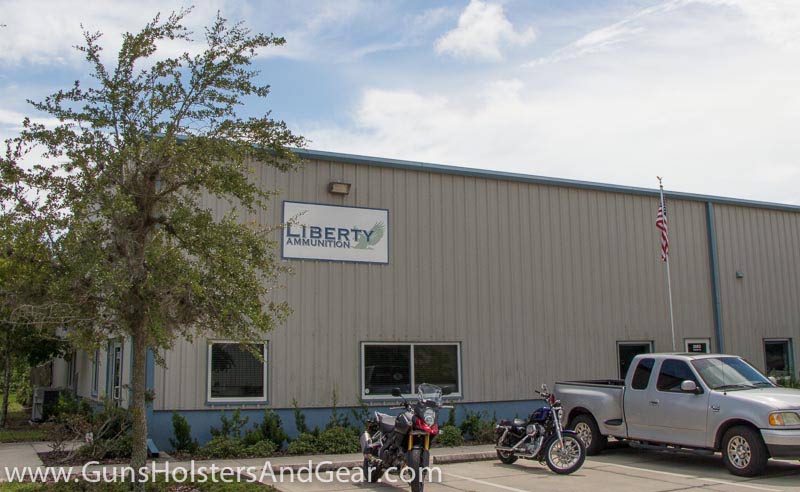
After September 11, 2001, Marx decided to devote his engineering talents to help protect US combat troops who were called to war. As a result, Marx began work on ceramic armor designs and specialized military ammunition. Later, Marx founded Liberty Ammunition with the intent of developing small arms ammo that would most effectively stop an attacker.
What Is Civil Defense?
Civil Defense is the company’s line of civilian ammunition. Put simply, it is designed to cause rapid incapacitation of a violent attacker by causing massive hemorrhaging while still providing enough penetration to crush bone and reach vital organs.
These loads use a bullet that is lighter-than-typical for the caliber, plus a few other tricks, to achieve very high velocities from standard handguns. Unlike some of the hyper-velocity loads that have been offered in the past from companies like Magsafe and Glaser (Corbon,) the Liberty bullets use a comparatively normal hollow point design.
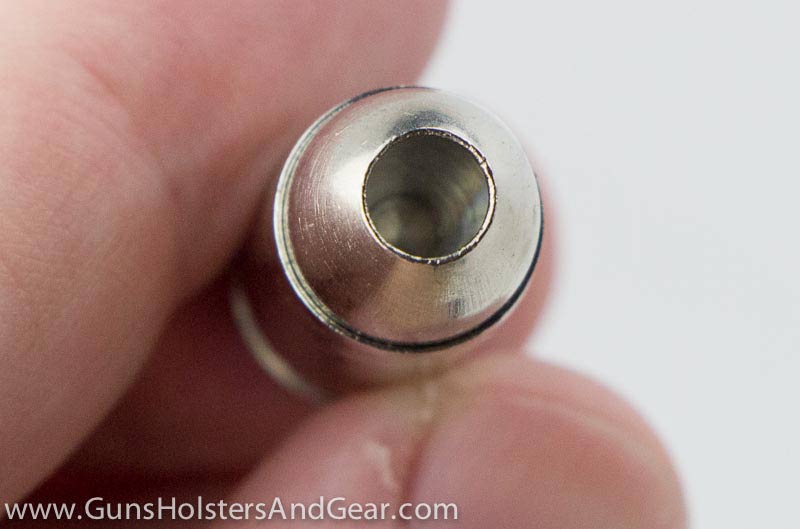
The Civil Defense bullet is a monolithic copper design with a very deep hollowpoint. The huge hollow area allows the load to maintain the correct overall length for the caliber while keeping the bullet much lighter than one would ordinarily expect.
Looking at the rounds, the silver color of the bullet jumps out at you. The color comes from the nickel jacket that is used in bullet construction. Copper is a relatively (for metal) sticky material. Even so, copper is used to jacket lead bullets because (1) lead is even softer and stickier than copper, and (2) copper is still soft enough to make it easy to work with.
Nickel, on the other hand, is well respected for its lubricity. By jacketing the copper bullets in nickel, friction in the barrel is reduced. This allows the bullet to travel faster on the same powder charge. It also has the side benefit of eliminating copper fouling of the bore.
Using a non-copper bullet jacket is not a new idea. A variety of alloys (mostly aluminum-based if I recall correctly) have been used by Winchester Ammunition to jacket their Silvertip line of hollowpoints. Federal Premium uses polymer as a jacket for their Nyclad bullets.
Liberty Ammunition currently offers six handgun loads in the Civil Defense line. The loads are
- 380 ACP – 50 gr JHP @ 1,500 fps
- 38 Special – 50 gr JHP @ 1,500 fps
- 9mm – 50 gr JHP @ 2,000 fps
- 357 Magnum – 50 gr JHP @ 2,100 fps
- 40 S&W – 60 gr JHP @ 2,000 fps
- 45 ACP – 78 gr JHP @ 1,900 fps
There are rumors of additional loads coming out in the near future, but unfortunately not anything I can confirm or deny. I have to wait until the 2015 SHOT Show like everyone else.
Got Me Under Pressure
References to ZZ Top aside, many people are understandably concerned about the pressures produced by high-velocity cartridges. All of Liberty Ammunition’s loads are within SAAMI specs for pressure and dimensions. In fact, Liberty Ammunition is a SAAMI member company, which is something that a number of other popular ammo companies cannot claim. [Ed. note: Liberty was a SAAMI member, but it is no longer listed as member.]
Pricing
Self-defense ammunition is rarely inexpensive, and the Civil Defense loads are no different. Today’s defensive ammo is vastly superior to what was available several decades ago. However, the improvements require a great deal of engineering and development. This costs money – a lot of money.
Liberty Ammunition costs are in line with other top shelf ammo. The MSRP is $26.49 – $34.99 depending on the caliber. Actual prices in the store are likely to be cheaper.
Shooting Meat, Jello and Cars – Liberty Civil Defense Ammo Review
Back in June, I got my first real exposure to the Civil Defense ammo at the Make Big Noise event in Shackleford, VA. Russ Datson, the company’s Director of Sales, was on hand with a bunch of the 9mm ammo to shoot. Everyone had a chance to put some rounds through a variety of pistols, plus some of the G4S International Training staff shot the ammo into gelatin, meat and cars.
The gelatin tests were pretty standard fare. Rounds were fired into gel blocks, both bare and denim covered. One attendee even had a towel on hand, so the ammo was shot through eight layers of terrycloth at his request. All of the rounds expanded and created rather large “wounds” in the gel. After about four inches of penetration, the core of the bullet continued straight, penetrating to about 12″.
The petals from the hollowpoint would peel back and then separate around the 3-4″ depth range. According to Datson, the bullets are designed to do this to maximize stopping power.
BBQ Pork – Hold the Lead
Datson also had a few pork roasts on hand. The G4S staff happily shot a roast with the Liberty ammo and then shot a second roast with a Hornady XTP 147-grain round. The difference in damage to the meat was quite dramatic. The Civil Defense ammo caused massive damage through the meat, while the XTP punched through the meat with a comparatively small wound track.
In fairness, I would never recommend anyone carry the Hornady XTP load as a self-defense round, but some people do. So, maybe the comparison is fairer than I give it credit for.
It Was No ’64 Skylark with Positraction
G4S staff pushed an 80’s era Buick onto the range, and we moved the testing to it. First up was the car door. Two rounds were shot through the passenger side, rear door from the outside of the car. One round was the Liberty Civil Defense while the second was the aforementioned Hornady XTP.

The Liberty round penetrated the steel door, inner door panel and then the door panel on the opposite side of the car. The XTP round penetrated the exterior steel but was stopped in the inner door panel. Granted, there are a lot of variables that can account for a lack of penetration by the XTP round. Considered on its own merits, the Civil Defense round certainly had enough juice to get to the passenger compartment.
For those that are curious, those 80’s Buicks were heavier than I remembered. I grew up riding around in a 1970 Plymouth Fury III, so an 80’s era car seemed pretty lightweight at the time. But compared to the downright anorexic cars of today, that 80-something sedan was a very solid beast.
Windshield glass is notoriously tough stuff for bullets to punch through. Frequently, a bullet will deviate from a straight path when hitting the glass.
The designated shooter from G4S fired rounds from inside the passenger compartment through the windshield. The rounds struck a target in front of the car at the point of aim without any obvious deviation from a straight path. Unfortunately, we did not have any additional gelatin on hand to see how well the bullet would have performed after encountering the laminated glass.
Rounds were also fired from in front of the car into the passenger compartment through a different section of the windshield. These rounds showed a very slight rise in the bullet’s path. Typically, a significant drop is seen with traditional ammunition. Again, we did not have any gelatin to measure the performance of the round once it had passed through the glass.
At the Shooting Range
Since June, I have shot the Liberty Ammunition through several guns as part of the testing of the pistols. For example, I shot a bunch of the 9mm Civil Defense ammo through the new HK VP9. Recently, however, I loaded a huge bag with many boxes of the ammo and headed out to a local range.
When I started to unload my bag onto the bench, one of the range officers came over. He silently watched me pull box after box of ammo out. Then he watched as I set more than a dozen handguns on the bench. He was understandably curious about why I was shooting so much ammo, and why I was using so many guns to do it.
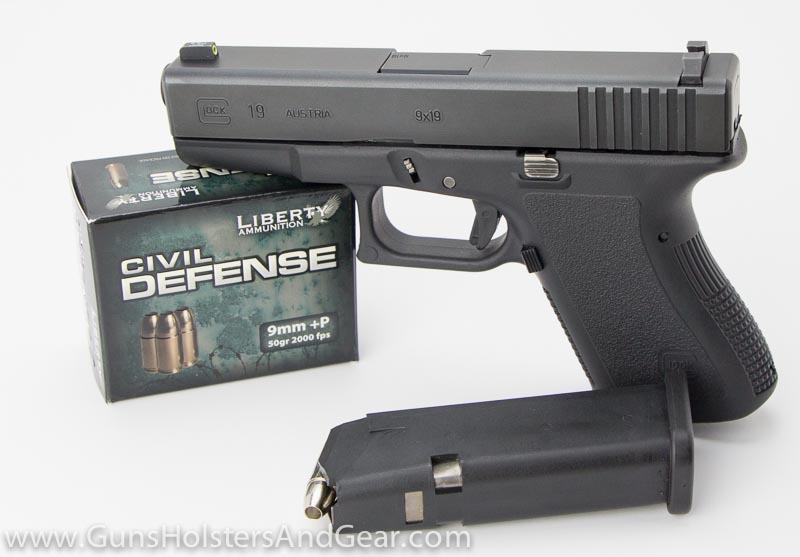
I told him about the ammo, and about my intentions to give it a test in all of the guns for both functioning and velocities. He was intrigued and spent much of the afternoon helping pick up brass, adjusting my chrono placement and generally helping out. (Thanks Paul!)
Recoil from a Semi-Automatic Handgun
With ammunition that is rated at such a high speed, it is perfectly understandable to be cautious about the recoil it might generate. However, the felt recoil was no worse than that of other self-defense ammunition. The notable exceptions were the 40 S&W and 45 ACP loads that had less felt recoil than “normal” defensive rounds.
.380 ACP Performance
| Barrel Length | Velocity | Energy | |
| Bersa BP380CC | 3.3″ | 1,400 fps | 218 ft-lbs |
| Glock 42 | 3.3″ | 1,368 fps | 205 ft-lbs |
| KelTec P3AT | 2.7″ | 1,294 fps | 186 ft-lbs |
| Rock Island Armory Baby Rock | 3.8″ | 1,388 fps | 214 ft-lbs |
| Ruger LCP | 2.8″ | 1,310 fps | 191 ft-lbs |
| Ruger LCP II | 2.8″ | 1,353 fps | 203 ft-lbs |
| SCCY CPX-3 | 3.0″ | 1,379 fps | 211 ft-lbs |
| SIG SAUER P238 Spartan | 2.7″ | 1,373 fps | 209 ft-lbs |
| Smith & Wesson Bodyguard 380 | 2.8″ | 1,337 fps | 198 ft-lbs |
| Smith & Wesson M&P380 EZ Performance Center | 3.8″ | 1,514 fps | 255 ft-lbs |
| Taurus Spectrum | 2.8″ | 1,341 fps | 200 ft-lbs |
The Civil Defense 380 ACP load was the weakest of the bunch that I tested. That said, these rounds still were zipping along at more than 1300 fps from both the Glock 42 and Bodyguard 380. I shot quite a bit of this ammo through the G42 and it ran 100%. It was an accurate combo, and at any range from about 15 yards in I would have no issue hitting what I needed to under stress.
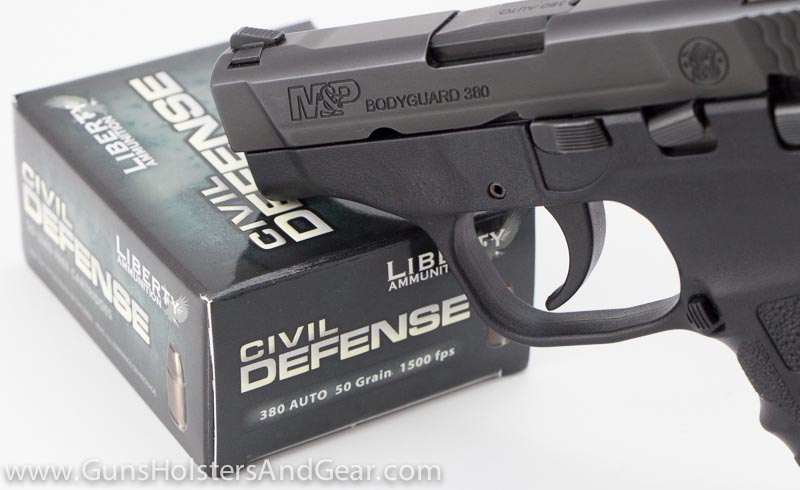
With the Bodyguard 380, the ammo was just as accurate as it was with the Glock. However, I did have two malfunctions. Both problems were failures to fire. Inspecting the cartridges, it looked like both primers were struck, but not very hard. Compared to the Glock, the BG 380 seemed to be striking the primers with a lot less force.
Although I am unable to prove it, it is my belief that the problem was gun-related, not ammo-related.
9x19mm Parabellum Performance
| Barrel Length | Velocity | Energy | |
| Bersa BP9CC | 3.3″ | 1,952 fps | 423 ft-lbs |
| Black Creek Precision AR Pistol | 10.5″ | 2,473 fps | 679 ft-lbs |
| Custom AR Pistol Build | 7.5″ | 2,386 fps | 632 ft-lbs |
| CZ P-07 Duty | 3.8″ | 2,015 fps | 451 ft-lbs |
| Dark Storm Industries DS-9 | 16.0″ | 2,563 fps | 729 ft-lbs |
| Diamondback AM2 | 3.5″ | 1,922 fps | 556 ft-lbs |
| Glock 17 Gen4 | 4.5″ | 2,087 fps | 483 ft-lbs |
| Glock 17 Gen4 in CAA RONI carbine kit | 16.0″ | 2,509 fps | 699 ft-lbs |
| Glock 19 Gen2 | 4.0″ | 2,069 fps | 475 ft-lbs |
| Glock 19 Gen4 | 4.0″ | 2,025 fps | 455 ft-lbs |
| Glock 26 | 3.4″ | 1,935 fps | 416 ft-lbs |
| Glock 43 | 3.4″ | 2,028 fps | 457 ft-lbs |
| HK VP9 | 4.1″ | 2,057 fps | 470 ft-lbs |
| Kahr CM9 | 3.1″ | 1,857 fps | 383 ft-lbs |
| Just Right Carbines Takedown | 17.0″ | 2,509 fps | 699 ft-lbs |
| Kalashnikov USA KP-9 | 9.3″ | 2,415 fps | 648 ft-lbs |
| Kalashnikov USA KR-9 | 16.3″ | 2,549 fps | 721 ft-lbs |
| Kel-Tec Sub2000 Gen 2 | 16.3″ | 2,510 fps | 700 ft-lbs |
| Ruger American Compact | 3.6″ | 1,950 fps | 422 ft-lbs |
| Ruger PC Carbine | 16.1″ | 2,500 fps | 694 ft-lbs |
| SCCY CPX-2 | 3.1″ | 1,825 fps | 370 ft-lbs |
| SIG SAUER MPX | 16.3″ | 2,390 fps | 634 ft-lbs |
| SIG SAUER Ultra Compact 1911 | 3.3″ | 1,924 fps | 411 ft-lbs |
| Smith & Wesson M&P Shield | 3.1″ | 1,899 fps | 400 ft-lbs |
| Springfield Armory Hellcat | 3.0″ | 1,863 fps | 385 ft-lbs |
| Springfield Armory Hellcat Pro | 3.7″ | 2,032 fps | 458 ft-lbs |
| Springfield Armory SA-35 | 4.7″ | 2,143 fps | 510 ft-lbs |
| Springfield Armory XD Service Model | 4.0″ | 2,042 fps | 463 ft-lbs |
| Springfield Armory XD Subcompact | 3.0″ | 1,915 fps | 407 ft-lbs |
| Springfield Armory XD-E | 3.8″ | 2,064 fps | 473 ft-lbs |
| Springfield Armory XD-S 4.0 | 4.0″ | 2,001 fps | 444 ft-lbs |
| Steyr S9-A1 | 4.5″ | 1,948 fps | 421 ft-lbs |
| Taurus 905 (revolver) | 2.0″ | 1,927 fps | 412 ft-lbs |
| Taurus G3c TORO | 3.2″ | 1,907 fps | 404 ft-lbs |
| Walther Creed | 4.0″ | 1,997 fps | 443 ft-lbs |
| Walther PPS | 3.2″ | 1,934 fps | 415 ft-lbs |
| Walther PPS M2 | 3.2″ | 1,805 fps | 362 ft-lbs |
| Wilson Combat WCP320 Carry | 3.9″ | 2,017 fps | 452 ft-lbs |
In 9mm, the Liberty is a screaming fast round. Out of the Glock 17, I saw an average of nearly 2,090 fps. Several individual rounds broke 2,100 fps. That seemed incredible for SAAMI-spec ammo from a duty-sized pistol.
The round was smoking-hot out of the Black Creek Precision pistol. This gun is an AR-style pistol chambered in 9mm, and with a 10.5″ barrel the ammo averaged an amazing 2,473 fps. That is actually faster than 55 grain .223 ammo from Hornady and Corbon that I’ve measured out of other companies’ AR-pistols. This could be a perfect pairing for home defense.
Velocity dropped off as the barrel lengths decreased. However, even the Smith & Wesson Shield with a 3.1″ barrel managed a hair under 1,900 fps. Oddly, from the even shorter barreled (2″) Taurus 905 revolver, the 9mm load streaked over the chronograph at an average of 1,927 fps.
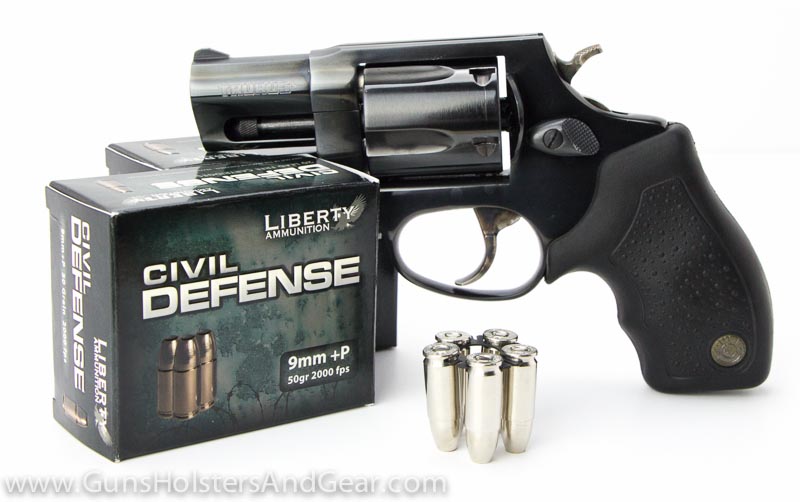
The 9mm ran perfect through all of my guns. One of the range officers had a SIG SAUER P938 that he offered to let me shoot. As it turns out, I experienced a failure to fire on the second round. Like the primers from the Bodyguard malfunctions, this primer was dented, but it was simply not as deep as the dents in the primers when shot from the other pistols.
On the fourth round with the SIG, I experienced a double-feed. After clearing the malfunction, I observed the rim of the fired case had a mark on it, presumably from the P938’s extractor. I shot the gun a few more times without any problems. I should again note that:
- the gun was not mine, so I have no idea if it had any existing problems, and
- all of the other 9mm pistols ran the ammo with 100% reliability.
I ran more than enough rounds through the SIG to get velocity recordings, but I failed to capture the information from the chronograph for this one. Doh.
.40 S&W Performance
| Barrel Length | Velocity | Energy | |
| Bersa BP40CC | 3.3″ | 1,875 fps | 468 ft-lbs |
| Glock 22 Gen3 | 4.5″ | 1,989 fps | 527 ft-lbs |
| Glock 27 Gen 3 | 3.4″ | 1,851 fps | 456 ft-lbs |
| Rock River LAR-40 | 16.0″ | 2,543 fps | 862 ft-lbs |
| SIG SAUER P226 | 4.4″ | 1,919 fps | 491 ft-lbs |
| Smith & Wesson Model 610 | 4.0″ | 2,078 fps | 575 ft-lbs |
| Smith & Wesson SD40 | 4.0″ | 1,930 fps | 496 ft-lbs |
| Springfield Armory XD40 | 4.0″ | 1,982 fps | 523 ft-lbs |
| Springfield Armory XD40 Subcompact | 3.0″ | 1,822 fps | 442 ft-lbs |
| Springfield Armory XD40 Tactical | 5.0″ | 2,111 fps | 594 ft-lbs |
I had three guns I tested the .40-caliber Liberty Ammunition in: a Glock 22, SIG P226 and a S&W SD40. All three guns ran the ammo with complete reliability. The advertised performance of the ammunition is 2,000 fps. Unlike the 9mm, I failed to meet or exceed that number in five-shot averages with these guns.
The G22 came the closest with an average of 1,989 fps. Two rounds did clock higher than 2,000 fps, but the five-shot average was less. The SIG and S&W pistols were closer to 1,900 than 2,000.
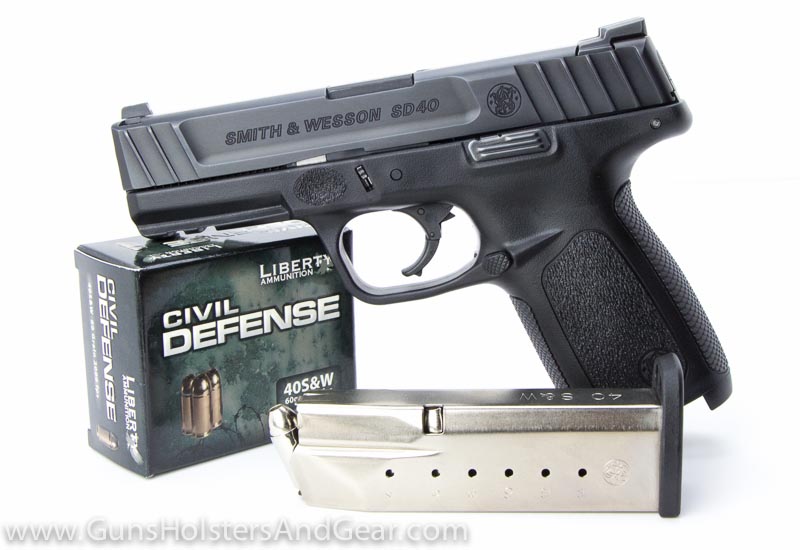
But, before anyone declares the load an underperformer, consider that even the slowest velocities I measured were making nearly 500 ft-lbs of energy. Considering the felt recoil on this load was less than that of other rounds in this caliber, I found that to be pretty impressive.
10mm Auto Performance
| Barrel Length | Velocity | Energy | |
| Smith & Wesson Model 610 | 4.0″ | 2,426 fps | 784 ft-lbs |
Unfortunately, I do not have many 10mm firearms. However, with the upswing in guns being chambered for the round, I expect this will change.
So far, I have tested the ammunition in a Smith & Wesson Model 610 with a 4″ barrel. This is an N-frame revolver that fires both 10mm Auto and .40 S&W rounds using moon clips. I tested 2019 manufactured ammunition in the gun – both 10mm and .40.
While the .40 S&W load was impressive, the Liberty Ammunition 10mm round was incredible. It averaged 2,426 fps on six shots – nearly 350 fps faster than the .40 S&W with the exact same bullet.
The 10mm and .40 S&W rounds tested in the Model 610 were manufactured in 2019 and showed tight spreads in velocities. For example, the 10mm produced a standard deviation of only 7 fps. Not too shabby for mass production ammunition.
.45 ACP Performance
| Barrel Length | Velocity | Energy | |
| Colt 1911 (circa 1972) | 5.0″ | 1,918 fps | 637 ft-lbs |
| Glock 21 Gen3 | 4.6″ | 1,916 fps | 635 ft-lbs |
| Kimber 1911 Classic Custom | 5.0″ | 1,932 fps | 646 ft-lbs |
| Springfield Armory XD | 4.0″ | 1,853 fps | 595 ft-lbs |
| Springfield Armory XD Tactical | 5.0″ | 1,980 fps | 679 ft-lbs |
| STI Escort 1911 | 3.2″ | 1,725 fps | 515 ft-lbs |
| Wilson Combat X-Tac Supergrade Pro | 5.0″ | 1,844 fps | 589 ft-lbs |
The stated velocity for the 45 ACP load is 1,900 fps. Actual performance was zippier from both a Glock 21 and a Kimber 1911 (5″ barrel.) Out of the 1911, this load approached 650 ft-lbs of energy. For a self-defense handgun, that is incredible. A traditional load will not approach that level of energy.
Final Thoughts on Liberty Civil Defense Ammunition
At this point, I’ve put hundreds of rounds of Civil Defense ammunition down range. Outside of the Liberty Ammunition company, I am probably one of only a handful of people who can honestly say that. What’s my verdict?
I like the ammo, and I would consider carrying it in my own firearms for protection. However, I do hesitate to be an early adopter of any new product that I would rely on to save my life.
Ammo and guns are not like the latest tablet or iPhone. If a tablet or other entertainment device fails, it can be annoying. Should a piece of life-saving gear fail, the consequences are grave indeed. I like being an early adopter for consumer tech, but not for life-saving tools.
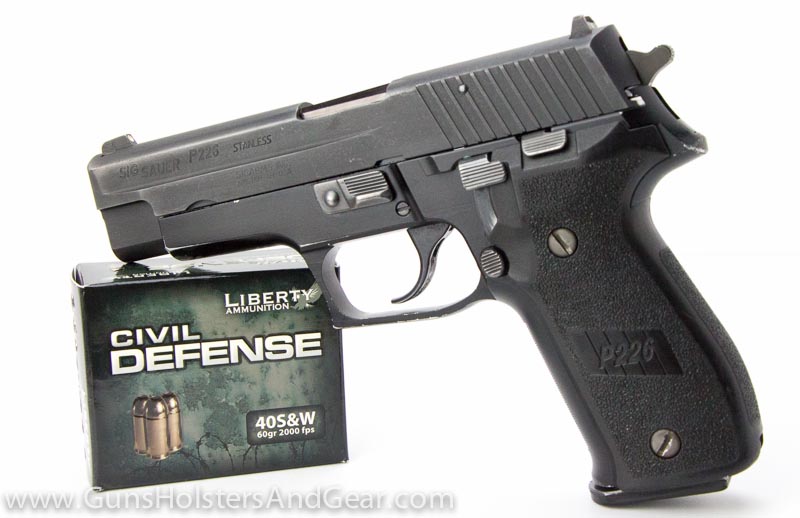
The malfunctions with the ammo in the Bodyguard and P938 are concerning, but not deal killers for me. The ammo ran flawlessly in all of the guns I have carried or would carry for self-defense.
The range officer’s SIG pistol that experienced problems is an unknown to me, so I have no way of judging what the cause of the malfunctions truly was. The Bodyguard 380 was a bit concerning as it has been an otherwise flawless performer. However, other people have reported problems with these guns. Read through the comments here to see some of the reported problems with the Bodyguard 380.
I am intrigued by the Civil Defense line of ammo from Liberty Ammunition. I think it is quality ammo that is priced in line with other self-defense loads. While I think it is more than merely a gimmick, I know that its street performance will ultimately prove if this is true or not.
However, until there is some body of evidence to show the rounds work in self-defense and law enforcement settings, I will continue to carry and recommend Federal HST and Speer Gold Dot rounds.
Disclosure for this Liberty Ammo Review
Unfortunately, there are a variety of information outlets online and in print that will run favorable reviews of products in exchange for money or other consideration. GunsHolstersAndGear.com is not one of them.
The ammunition used in this ammo review was provided to me by Liberty Ammunition and by Randall of Thin Blue Florida. I agreed to test the ammunition and publish my review here. I made no promises to provide anything other than my honest opinion on the ammo, which I have done.
At the time of this writing, Liberty Ammunition is not an advertiser, nor am I in talks with them to become one. Randall’s a friend, and I would never charge him for advertising anyway.
GunsHolstersAndGear.com is a for-profit website. I do not charge readers a dime to access the information I provide.
Some of the links on this page and site are affiliate links to companies like Amazon and Palmetto State Armory. These links take you to the products mentioned in the article. Should you decide to purchase something from one of those companies, I make a small commission.
The links do not change your purchase price. I do not get to see what any individual purchases.
Last update: July 10, 2024
I personally think that ammunition, or ammo, in guns from Liberty Ammunition for civil defense mades a lot of sense. I don’t care if you own a Glock, Smith & Wesson, Ruger, Taurus, Springfield Armory, Colt, CZ or other handgun – be it a revolver or semi-automatic pistol. All people should get out on the shooting range and practice self-defense skills and exercise CCW concealed carry with a handgun holster.

19 replies on “Liberty Ammunition Review: Civil Defense Line”
Great review. The only thing I found missing were data from say a Glock 27 and a Sig P224, i.e. short-barreled, larger caliber concealed carry guns. I see that you included a Glock 26, which is great, but for me it is still a minimum caliber. With loads this light it makes larger, heavier guns more comfortable to carry and, as you note, more comfortable to shoot with noticeably lower recoil as well. That makes the .40 cal. and .45 cal. guns more appealing and a higher likelihood of being carried for some people. Still, a very helpful review, and greatly appreciated.
Hi Bevan,
Thanks for the feedback. You make a great point about the ammo in larger caliber handguns. Unfortunately, I don’t have any short barrel pistols in these two calibers right now. However, as I get different guns for testing, I will run the ammo through them and update the information on this page.
Richard
I just bought some of the .380. It will go in a Bodyguard. It just seems that a bullet this light will generate much less energy for cycling the action. It mostly goes out the front because there is not much weight for it to push against. That may be what happened with the cycling issues. These little pistols have heavier springs since there is much less distance for the slide to travel.
Could you use the Liberty 9mm ammo in a Ruger SR9C pistol? Any concerns or issue you might have?
HI Gary,
All of the Liberty ammo is SAAMI spec, so it should work just fine. I always suggest running a box or two through the gun before carrying it just to make sure, but that is with any ammo you might consider.
Best,
Richard
Was the Bodyguard 380 the new M&P version like the picture, or the previous version connected to the link you provided? I’m considering the purchase of and M&P Bodyguard and, since I already use Liberty’s 9mm ammo, was thinking of using their 380ACP. Just doing do diligence before deciding on both. Thanks!
The photo is of the gun I used.
5 different 9mm Glocks but no Beretta 92 FS or M9? WTH??
I can understand not including the SIg P232 in the .380 test (although it is vastly superior to the Bersa but of course the Bersa is half the price), but not including a widely used standard like the Beretta 92FS/M9 is a huge oversight (especially when you managed to do five different Glocks instead)
I’m afraid I don’t have a 92 series pistol on hand to shoot, otherwise I would have included the specs. Ditto on the P232.
However, I continue to add guns to the list as I get guns in for testing. For example, I will be heading to the range tomorrow with a Walther PPS in 9mm. That will be added to the list shortly thereafter.
Hopefully, you still found some value in my review of this ammunition.
-Richard
The Bersa .380 Thunder/CC continue to get criticism but, they are one of the most underrated handguns on the market. The Sig P232 while a very good gun is not “vastly superior”. It’s fit, finish and refinement are there and yet, the bersa goes bang every time, is relatively accurate and is a breeze to maintain…..bottom line? It, like S&W’s SD line are vastly superior in value to guns costing twice as much? I have yet to get any of my SW SD’s to fail with ANY load, mixed mags, or anything I throw at it….a true knock off copy of a Glock and good one at that….their slides are buttery smooth in operation. The Gen 1’s has stiff 10-11lb triggers that soften with time or, simply change the springs….the Gen 2’s are an improvement but, still mushy….at 7-20 yards? NOT an issue…again, at $279 new, they are vastly superior in value to guns that cost twice as much…..no knock on the more expensive weapons as I own them as well (Beretta, Glocks, Rugers, Sigs, Colt, more Sigs, etc…..).
This is an excellent review on an age old concept. I always believe 99.999999% of self defense shootings will face no more than a heavy jacket or light barrier…..this proves the concept. Ammo can be light and when physics are applied the foot lbs of energy do not lie. I have been looking for reliable HP ammo like this for my pocket guns (Taurus TCP 380, Kel-Tec PF9 and SW 442) because unlike all the liars out there, I do NOT carry a 1911 around as it’s the weight of a brick, unloaded no less, albeit a competent and time proven gun….just can’t carry it unless you work in a job where no one cares…not too many jobs like that around my friend…..toting around a full frame anything during working hours is laughable and 99.9999% of the people that say they do, lie. Period. They are just too damn big. Ergo the onslaught of single-stack .380’s and 9mm’s?????
While consumer buying patterns don’t lie. 1911 owners tend to…..that aren’t “Death Rays” sent down by Zeus, God, Buddha, Mookie, Bingo or Zippy either.
No matter, loved the review. It’s a no BS review and who can’t appreciate THAT for a change. Having worked for a magazine and in that industry in the past I guarantee that most trade reviews for ad dollars. Period. Puff pieces abound and the gun industry is no different. This one is straight-forward. Exciting development in self-defense ammo and I would not be afraid to carry it.
The same people that crap on this light bullet theory are the same ones that say the .22 will just “piss em’ off” and I have YET to see someone raise their hand and let me prove they are wrong by shooting them 2-3 times with some .22 HP ammo out of a short barrel? Any takers? Didn’t think so….
This technical application makes sense. Nickel is truly more “slippery” than soft copper or even lead which can drag on rifling. I’m not sure that it will affect barrel life much but, not too many put 100,000 rounds through their pistols as they claim. Why? They couldn’t f’in afford it. Period. Most are lucky to put 1,000-3,000 rounds in a lifetime of ownership. So, barrel wear is moot. ALL barrels can withstand the “brutal” punishment of whatever 1,000-3,000 rounds you wish to push through them. Have at it Kilroy.
Good review. Makes sense. I’m going to try some in my .380’s, 9mm’s and .38’s. I need something to offset the felt recoil in 9mm and .38 with current loads. If this is equal, I would say it’s superior. The roundness of the bullet will promote excellent feeding no matter the initial oscillations incurred upon ramp feeding me thinks. If it can load, it should go bang. The velocity is compelling. It would be nice to see if the recoil is actually more manageable in the sub compact 9mm’s or .38’s.
Good read. Thanks,
Thanks for taking the time to leave your thoughts and feedback. I like some expensive guns, but as you say there are a lot of great guns that are very affordable. Like you, I really like the SD line from Smith & Wesson as an example of this.
Thanks again for leaving feedback. I am trying to provide the information that people want in a way that is both readable and reliable.
Great, Common Sense Review!
Great to learn about the “Slickness” of Nickel coated bullets!
The Reminder for the Day: “RAMP AND THROAT”
One recurring question keeps coming up in my “Been Around Quite a Long Time!” mind, re. the intermittent feeding problems, often mentioned in regard to newer Semi Autos and hollow points, almost despite the nose design of the bullet…obviously, the “Great Yawning Volcanic Crater” HP might have feeding problems, but the issues get down to the older HPs made by Corbon as well, and one should not be deprived of a great defensive round for this very fixable problem!
(By the way, I just fill in the massive HP craters with cigarette butts, so in case the BG gets out of hospital in relatively 1 piece, the Cancer, Stroke and Heart Attack will get him later! (LOL))
I own several calibers of handguns, and have had a gunsmith do a “RAMP AND THROAT” polish job on every gun that might see serious defensive service. PROBLEM SOLVED PERMANENTLY! I don’t own a gun newer than 22 years (Glock 19, Gen 1), and every type of HP that came along since then has fed perfectly on every one of my guns.
Don’t know what the R & P Job costs nowadays, but it was about $25.00 or less back then, and worth every cent!
Interesting writing , Speaking of which if you are interested in a Form UCC1 , I came across a template form here
Thanks for the write up. Is there a difference in quality/velocity in the older stuff (which I have) and the 2018+ lots? Any word on what has become of Liberty as of May 20, 2019?
Hi Reece,
Liberty is in full operation and shipping ammo. They are also developing new loads for both rifle and handgun cartridges not yet served. I had an off the record conversation earlier this week with one of their people and the new load they are working on sounds pretty amazing.
As to the differences, I’m not sure there are any. I’ve been keeping track of what the new ammunition is doing to compare it to the older stuff. I think it is exactly the same, but until I get a larger data set, I won’t be able to draw any reasonable conclusions.
For what it’s worth, I’ve run 9mm and 10mm (new production) through some guns in the past two months. All of it has been 100% reliable.
Best,
Richard
I have a Rugar P-90 45 ACP your ammo was suggested to me. Can u please provide any info on results for my gun.
I just ran about 100 rounds of the 69 grain .40 s/w through a 5 inch Walther PPQ m2. Mind you, I just went directly to the range with the firearm and started training. I had 3 fail to go into full battery. This would be the slide would cycle, pick up a fresh round then stop with the round about 1/2 way into the barrel.
The rounds were fantastic, hot and accurate I think the issue was more gun (mag spring??) than the ammo.
The sectional density will be low with a 50gr 9mm bullet…Like a flat button slapping on the surface…Any issues with reduced penetration?
I shot .380 Liberty Civil Defense through my new Ruger LCP Max last week. As Compared to the Federal ball rounds I shot first, it was a lighter recoil.